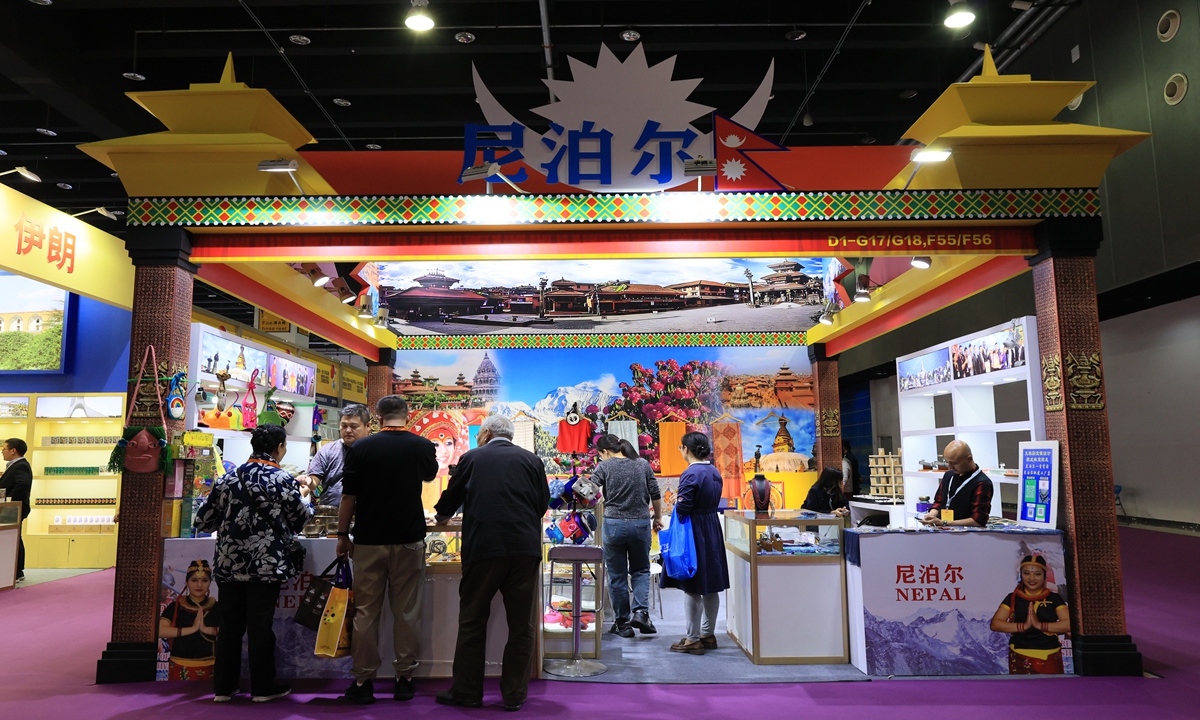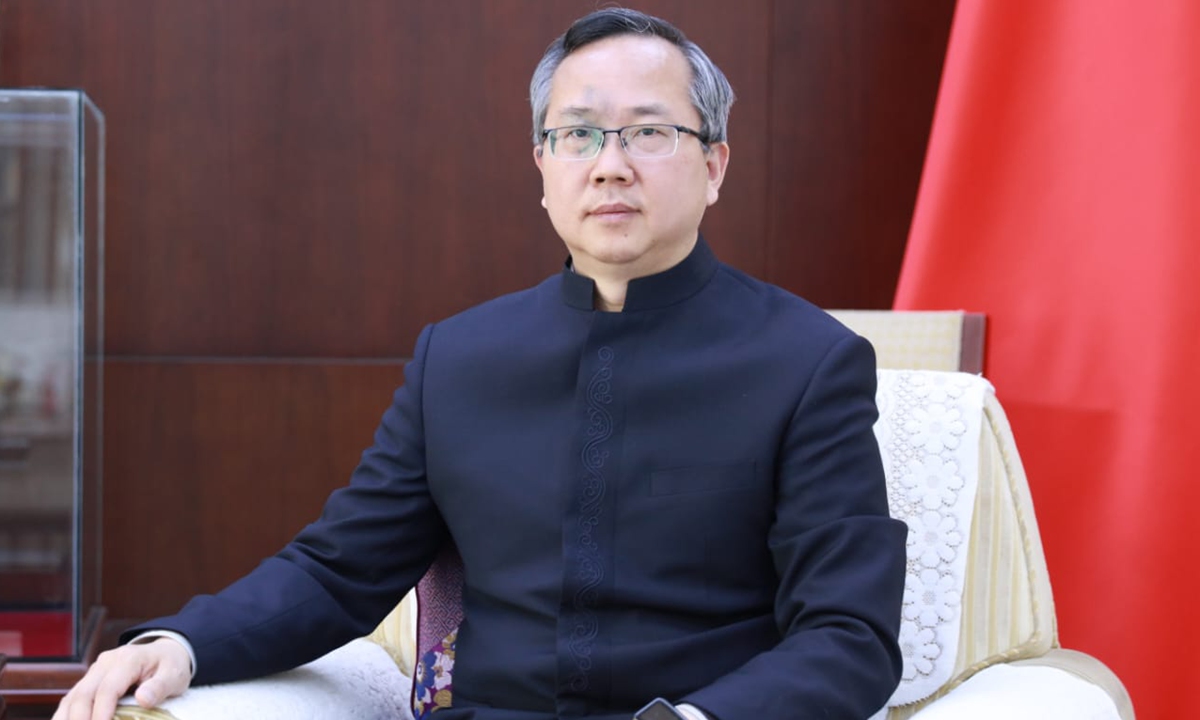
Visitors browse and select items at the Nepalese imports booth during the 2024 China Yiwu International Commodities Fair - Export Goods Exhibition on November 13, 2024. Photo: VCG
Editor's Note:
Trade in the Himalayan region has seen robust growth in 2024, with Nepal's trade with Southwest China's Xizang Autonomous Region skyrocketing by 75.8 percent year-on-year to 4.42 billion yuan ($606 million) in the first 11 months. China and Nepal signed a framework agreement to promote Belt and Road cooperation in early December. The Global Times (
GT) reporter Chu Daye recently had an exclusive interview with the Chinese Ambassador to Nepal Chen Song (
Chen), during which the envoy shared his views on the latest development of bilateral trade and economic cooperation and China's Belt and Road cooperation with the South Asian country.
GT: Nepali Prime Minister KP Sharma Oli visited China in early December. What is the significance of this visit, especially since it was his first foreign trip since assuming office?
Chen: The Nepali Prime Minister's visit fully reflects the high level of mutual political trust between the two countries and the consensus on a friendly relationship with China by Nepal's ruling and opposition parties and all sectors of society. The visit is the most important high-level exchange between China and Nepal in 2024. The meetings with Chinese leaders with Oli have drawn up the blueprint for mutually beneficial cooperation, and it is of great significance to the development of China-Nepal relations in the new era.
First, political mutual trust between China and Nepal has reached a new height. Second, China-Nepal practical cooperation has entered a new era, as highlighted by the two sides' signing of a cooperation agreement on the Belt and Road Initiative (BRI). It plans to strengthen the interconnection of ports, transportation, power grids, communications, trade, infrastructure, disaster relief, and poverty reduction and deepen cooperation in youth, education, culture and tourism. The two sides signed a protocol on Nepalese beef export to China, which will help Nepal's competitive products enter the huge market of China and share China's development dividend to better realize Nepal's social and economic development. Third, China and Nepal have jointly entered a new stage in facing global challenges, with the two sides jointly safeguarding international justice and the common interests of developing countries.
GT: China and Nepal have signed a framework agreement to promote Belt and Road cooperation, what are the next steps in implementing this agreement?
Chen: Since the BRI was proposed, China and Nepal have maintained close communication and collaboration on promoting the BRI cooperation. In 2017, the two sides signed a memorandum of understanding (MoU) on bilateral cooperation under the framework of the BRI. In recent years, China and Nepal have jointly promoted high-quality BRI cooperation, yielding fruitful results. A Trans-Himalayan Multi-Dimensional Connectivity Network has taken shape, with results in economic and trade cooperation, international development cooperation, people's livelihood projects, and people-to-people and cultural exchanges.
Based on political consensus at the highest-level and the MoU between the two countries, the two sides inked the cooperation framework agreement. This is not only a tribute to the recently concluded fourth symposium on Belt and Road construction work but also bears special significance to the high-quality development of the BRI.
The agreement is pragmatic and highlights the field of cooperation in the next phase. It aims to promote the socio-economic development of Nepal with more policy and fund support from China, help improve Nepal's trade and investment environment, vital infrastructure such as transportation and energy, and increase the Nepalese economy's "blood-making" function to drive growth. The agreement will also deepen regional cooperation, and promote broader regional cooperation between China and South Asian countries, contributing to regional peace, stability and common development. Also, the agreement serves to strengthen people-to-people exchanges, enriching bilateral cultural and tourism cooperation.
In the next phase, based on existing cooperation, both sides will encourage the deepening of economic, financial, transportation, interconnection and logistics. And promoting exchanges and cooperation in trade, industry and investment, as well as cooperation in customs, education, health and medical care. Both sides will fully consider their respective development stages and advantages, especially Nepal's specific development needs and priorities.
GT: China and Nepal have expressed willingness to steadily advance the feasibility study of the Jilong/Keyrung-Kathmandu Cross-Border Railway, what is the latest progress in the project, and what role will the railway play after completion?
Chen: China-Nepal cross-border railway project (Overseas Section) feasibility study project is an important part of the construction of the Trans-Himalayan Multi-Dimensional Connectivity Network. The Chinese and Nepalese governments have long committed to the advancement of this project. An implementation agreement was signed in December 2022 between the two sides and the first phase of feasibility study was completed between March 2023 to January 2024.
A second phase of the feasibility study has been underway since March 2024, with Chinese railway technical, surveying and drilling personnel in Nepal doing the job. Multiple assignments have been completed and it is estimated that 60 percent of overall progress in ground surveying has been completed by the end of November. It is expected that the geological prospecting work will be completed relevant reviews passed by June 2025 and the overall feasibility study completed in 2026.
The elevation fall of the China-Nepal cross-border railway project is very large. It is a world-class challenge to build railways in this extreme geological condition and full research in advance is required before discussing specific practical issues and implementation.
However, with China's rich experiences and technical expertise for building railways in mountainous and plateau areas, I believe that based on the cooperation between top scientific research institutions of China and Nepal, we will surely be able to overcome difficulties and speed up cross-border railway technical research to ensure its earlier completion.

Chen Song, Chinese Ambassador to Nepal Photo: Courtesy of the Chinese Embassy in Nepal
GT: Some in the international community, as well as in Nepal, express caution regarding the acceptance of loans. What are your thoughts on the relationship between development and debt?
Chen: Development is inseparable from capital accumulation and investment. However, developing economies do not have much blood-forming function. If you rely solely on that economy's internal strengths, you cannot achieve rapid growth in a short period and complete the chain events of capital accumulation, asset investment, production capacity expansion, and development. As a result, the pace of development can be very slow.
Therefore, moderate external financial support can help boost an economy's modernization drive. At the same time, we must also note that developing countries are more vulnerable to external shocks such as monetary policy spillovers of developed countries and fluctuations in the risk appetite of international investors.
Western financial institutions, in pursuit of high profits and to maximize gains, have for many years encouraged developing countries to issue large volumes of short-term high-yield bonds. This has resulted in many a developing country facing huge debt repayment pressure, squeezing their development space.
Data from the Nepal Public Debt Management Office shows that as of the end of the 2023-24 fiscal year, the Nepalese government's external debt is 1.25 trillion Nepalese rupees ($9.12 billion), of which multilateral debt accounted for 88.98 percent, and bilateral debt accounted for only 11.02 percent. Among them, Japan and India are the top two bilateral creditors, with China ranking third, accounting for 2.82 percent of total debt.
Some Western countries' jumping to hype up the "debt trap by China" is a move aimed at smearing and discrediting China's cooperation with developing countries. China adheres to "promoting debt reduction through development" and has been committed to providing more efficient means of financing to Nepal including low-interest loans, development assistance, and investment for many years.
GT: How do you evaluate the two sides' progress in jointly building BRI in 2024? What will the accelerated cooperation between China and Nepal bring to South Asia?
Chen: There has been solid progress. First, the "hard connectivity" of infrastructure has achieved fruitful results and the level of interconnection has improved. Now 14 traditional border trade points between the two countries have been fully opened, and the number of direct flights between China and Nepal has increased to 48 flights per week. Progress was made for multiple highways, including the China-aided Araniko Highway and the Hilsa-Simikot Road. The feasibility study of the China-Nepal cross-border railway and cross-border power grid also saw accelerated progress.
These came as some cooperation agreements were inked to foster the soft aspect of connectivity, promoting the docking of China-Nepal development strategies, economy and trade, and cooperation in education, media and other fields. Lastly, Chinese and Nepalese people-to-people continue to deepen.
A series of "small but smart" projects that benefit people's livelihood have taken root and helped improve the quality of Nepal people's livelihood.
The accelerated high-quality co-construction of the BRI between China and Nepal is continuously expanding in scope and elevating in levels.
Promoting policy communication and infrastructure development, it is driving investment and trade growth, facilitating personnel exchanges, optimizing the cooperation environment, and advancing regional integration. This not only brings positive impacts on the political stability, economic development, and social progress of both China and Nepal but also benefits the entire South Asian region.





